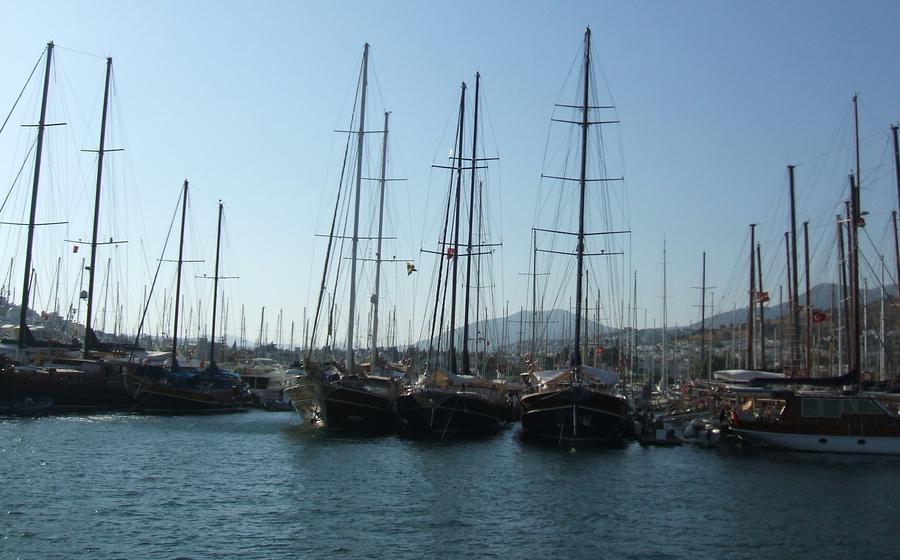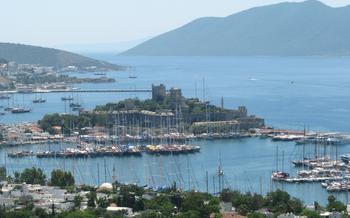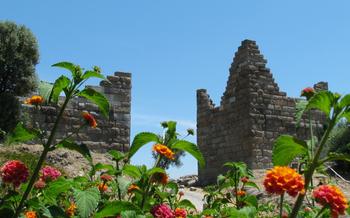
Ancient Agora Open Air Museum
- Bodrum's Ancient Agora: Unraveling History's Tapestry
- A Journey Through Time: Exploring the Agora's Ruins
- The Agora's Architectural Masterpieces
- Gateways and Entrances
- Colonnades and Stoas
- Statues and Sculptures
- Mosaics and Inscriptions
- The Agora's Artifacts: Whispers from the Past
- The Agora's Historical Context: Bodrum's Rich Past
- The Agora's Enduring Legacy: A Symbol of Resilience
- Planning Your Visit: Essential Information
- Exploring the Agora Independently: A Self-Guided Tour
- Beyond the Agora: Uncovering Bodrum's Treasures
- Immerse Yourself in Bodrum's Culture: Local Cuisine and Traditions
- Practical Tips for a Memorable Visit: What to Know Before You Go
- Bookstores and Libraries: Delving Deeper into Bodrum’s History
- Capture the Agora's Essence: Photography Tips and Inspiration
- Unique Souvenirs and Local Crafts: Preserving the Memories
- Insider Tip: Unveiling the Agora's Hidden Corners
Bodrum's Ancient Agora: Unraveling History's Tapestry
In the heart of Bodrum, Turkey, lies the ancient agora, a testament to the city's rich historical legacy. Once a bustling marketplace and civic center, the agora served as a vibrant hub of activity in ancient times. As you step through its gates, you'll embark on a journey through history, uncovering the secrets of a bygone era.
Archaeological excavations have revealed a treasure trove of artifacts and structures that paint a vivid picture of daily life in ancient Bodrum. From intricate statues and sculptures to well-preserved shops and stalls, the agora offers a glimpse into the commercial, political, and social interactions that shaped this ancient city.
Over the centuries, the agora has undergone various transformations, reflecting the changing fortunes of Bodrum. Despite its eventual decline and abandonment, the agora's legacy endures, thanks to extensive restoration efforts that have preserved its ruins for future generations. Today, it stands as a symbol of resilience, showcasing the enduring power of history.
A Journey Through Time: Exploring the Agora's Ruins
The agora of ancient Bodrum, once a bustling marketplace and civic center, offers visitors a captivating journey through time. As you wander through its ruins, you'll discover a carefully planned layout featuring streets lined with shops and public buildings. The agora's religious significance is evident in the Temple of Zeus, a testament to the city's devotion to the Olympian gods. Other sacred structures, such as altars and shrines, dot the site, providing glimpses into the spiritual lives of the ancient inhabitants.
The agora's commercial hub bustled with activity in ancient times. Shops and stalls lined the streets, offering a variety of goods from pottery and textiles to jewelry and spices. Merchants from across the region gathered here to trade their wares, creating a vibrant and cosmopolitan atmosphere. The agora also served as a civic center, housing government buildings and meeting places where citizens discussed important issues and made decisions that shaped the city's future.
The Agora's Architectural Masterpieces
The Ancient Agora of Bodrum boasts a remarkable collection of architectural masterpieces that showcase the artistry and ingenuity of ancient builders. As you wander through the ruins, you'll marvel at the grand gateways that once served as entrances to this bustling marketplace and civic center. These imposing structures, adorned with intricate carvings and sculptures, offer a glimpse into the grandeur and significance of the agora in ancient times.
Gateways and Entrances
The agora's gateways are not mere entrances but works of art in their own right. The Main Gate, situated on the eastern side of the agora, is particularly impressive. Its towering archway, flanked by two massive towers, creates a sense of awe and grandeur. The gate is adorned with elaborate reliefs depicting scenes from Greek mythology, adding a touch of divine significance to the entrance.
Colonnades and Stoas
As you step through the gateways, you'll find yourself surrounded by elegant colonnades and stoas that line the agora's streets. These covered walkways, supported by rows of slender columns, provided shade and protection from the elements for the merchants and shoppers who frequented the agora. The stoas were also used for a variety of public functions, such as meetings, assemblies, and religious ceremonies.
Statues and Sculptures
The agora was once adorned with a wealth of statues and sculptures that celebrated gods, heroes, and prominent figures from history. While many of these treasures have been lost or damaged over time, a few remarkable pieces remain. In the center of the agora, you'll find the imposing statue of Zeus, the king of the gods, which once stood atop a grand pedestal. Other notable sculptures include a headless statue of Aphrodite, the goddess of love and beauty, and a well-preserved statue of Hermes, the messenger of the gods.
Mosaics and Inscriptions
The agora's ruins are also adorned with exquisite mosaics and inscriptions that provide valuable insights into the history and daily life of ancient Bodrum. These intricate artworks depict scenes from mythology, everyday life, and religious rituals. The inscriptions, often carved into stone tablets or pedestals, record important events, laws, and dedications. Together, the mosaics and inscriptions bring the ancient agora to life, allowing visitors to imagine the vibrant atmosphere and bustling activities that once filled this remarkable space.
The Agora's Artifacts: Whispers from the Past
The Ancient Agora of Bodrum yields a treasure trove of artifacts that whisper tales of the city's vibrant past. Among these relics, pottery and ceramics stand out as testaments to the exceptional craftsmanship of ancient artisans. These vessels, adorned with intricate patterns and motifs, offer glimpses into the daily lives and cultural traditions of Bodrum's inhabitants.
Coins and currency unearthed at the agora provide valuable insights into economic activities and trade routes that connected Bodrum to distant lands. The discovery of bronze and silver coins, as well as foreign currency, highlights the city's role as a commercial hub and its interactions with diverse cultures.
Everyday tools and utensils, from humble cooking pots to finely crafted bronze tools, offer a tangible connection to the domestic life of the agora's residents. These artifacts reveal the practical aspects of daily existence, from preparing meals to engaging in various crafts.
Religious objects, such as votive offerings and cult statues, provide a glimpse into the spiritual beliefs and practices of Bodrum's ancient population. These artifacts, often intricately carved or decorated, shed light on the religious rituals and deities worshipped in the city.
Taken together, the artifacts of the Ancient Agora of Bodrum form a mosaic that brings the city's history to life, narrating tales of trade, craftsmanship, domesticity, and spirituality. These relics invite visitors to delve into the rich tapestry of a civilization that once thrived within these ancient walls.
The Agora's Historical Context: Bodrum's Rich Past
Ancient Halicarnassus
The Ancient Agora of Bodrum was an integral part of ancient Halicarnassus, one of the most prominent cities in Caria, a region in southwestern Anatolia. Halicarnassus was founded around the 6th century BC and quickly rose to prominence as a center of trade, culture, and politics. The city was renowned for its impressive fortifications, its beautiful harbor, and its vibrant cosmopolitan atmosphere.
The Mausoleum at Halicarnassus
One of the most famous landmarks of ancient Halicarnassus was the Mausoleum, a magnificent tomb built by Mausolus, the satrap of Caria, in the 4th century BC. The Mausoleum was considered one of the Seven Wonders of the Ancient World and was described by ancient writers as being of extraordinary beauty and grandeur. Unfortunately, the Mausoleum was destroyed by earthquakes in the Middle Ages, and only a few fragments remain today.
Alexander the Great's Conquest
In 334 BC, Alexander the Great conquered Halicarnassus after a prolonged siege. The city was largely destroyed, but Alexander ordered its reconstruction and made it the capital of his newly acquired province of Caria. Under Alexander's rule, Halicarnassus experienced a period of growth and prosperity.
Byzantine and Ottoman Influences
After the fall of the Roman Empire, Halicarnassus came under Byzantine rule. During this period, the city's Christian population grew, and several churches and monasteries were built. In the 15th century, Halicarnassus was conquered by the Ottoman Turks, who renamed it Bodrum. The Ottomans ruled Bodrum for over 400 years, and during this time the city's character changed significantly. The old Byzantine churches were converted into mosques, and the city's population became predominantly Muslim.
The Agora's Enduring Legacy: A Symbol of Resilience
Despite its decline and abandonment in late antiquity, the Agora of Bodrum stands as a testament to the resilience and enduring legacy of ancient civilizations. The reasons for its decline are still debated by historians, but it is believed that factors such as political instability, economic decline, and natural disasters may have contributed to its eventual abandonment.
Rediscovered in modern times, the Agora's ruins were brought to light through extensive excavations that revealed the grandeur and complexity of this once-thriving marketplace and civic center. Conservation and preservation efforts have been ongoing since its rediscovery, ensuring that this valuable piece of history is protected for future generations.
In recognition of its outstanding universal value, the Agora of Bodrum was designated as a UNESCO World Heritage Site in 20This prestigious status further underscores the significance of the site and the international community's commitment to preserving and protecting it for the benefit of humanity.
The Agora of Bodrum stands as a poignant reminder of the ephemeral nature of human endeavors, yet it also serves as a testament to the enduring power of history and the resilience of the human spirit. Its ruins continue to captivate visitors, offering a glimpse into the rich cultural heritage of Bodrum and the enduring legacy of ancient civilizations.
Planning Your Visit: Essential Information
Visiting the Ancient Agora of Bodrum is a rewarding experience that offers a glimpse into the rich history and culture of the region. Here's some essential information to help you plan your visit:
-
Location and accessibility: The Ancient Agora is located in the heart of Bodrum, a short walk from the picturesque harbor. Visitors can easily reach the site on foot from most hotels and guesthouses in the city center. Public transportation options are also available, with buses and taxis providing convenient access to the agora.
-
Operating hours and fees: The Ancient Agora is generally open to the public daily from 8:00 AM to 6:00 PM. Admission fees are nominal, and there are reduced rates for students and children. It's advisable to check the official website or contact the Bodrum Museum for the most up-to-date information on operating hours and fees.
-
Guided tours and resources: Guided tours of the Ancient Agora are available in various languages. Pre-booking a guided tour is recommended, especially during the peak tourist season, to ensure a spot and benefit from the expertise of a knowledgeable guide. Informative brochures, maps, and audio guides are also available for self-guided tours, enabling visitors to explore the site at their own pace.
-
Accessibility for differently-abled visitors: The Ancient Agora is partially accessible for visitors with disabilities. Wheelchair ramps and accessible pathways have been installed to facilitate movement within the site. However, some areas may still be challenging to navigate due to the uneven terrain and historical structures. Visitors with specific accessibility requirements are advised to contact the Bodrum Museum in advance to make arrangements for assistance.
Exploring the Agora Independently: A Self-Guided Tour
Embark on a journey of discovery through the Ancient Agora of Bodrum with a self-guided tour. Begin your exploration at the main entrance, where you'll be greeted by the impressive gateway that once welcomed visitors to this bustling marketplace. Stroll along the ancient streets, lined with the remains of shops and stalls, and imagine the vibrant atmosphere of trade and commerce that filled the air centuries ago.
As you wander through the agora, be sure to visit the Temple of Zeus, a sacred sanctuary dedicated to the king of the gods. Admire the intricate carvings and architectural details that adorn the temple, and reflect on the religious significance this site held for the ancient Greeks.
Don't miss the opportunity to explore the agora's civic center, where important decisions were made and laws were enacted. Here, you'll find the remains of government buildings and meeting places, offering a glimpse into the political and administrative functions of this ancient city.
As you continue your self-guided tour, keep an eye out for the exquisite statues and sculptures that once adorned the agora. These masterpieces depict gods, heroes, and prominent figures, providing a glimpse into the artistic and cultural achievements of ancient Halicarnassus.
Finally, make sure to visit the agora's museum, which houses a collection of artifacts and relics unearthed during excavations. Here, you'll gain a deeper understanding of the agora's history and the daily lives of its inhabitants.
Allow yourself approximately two hours to fully explore the agora and immerse yourself in its rich history. As you wander through the ruins, let your imagination transport you back in time to the bustling marketplace and civic center that once stood here.
Beyond the Agora: Uncovering Bodrum's Treasures
The Ancient Agora is just one of the many historical and cultural gems that Bodrum has to offer. Beyond the agora's ruins, visitors can embark on a journey of discovery to uncover the town's other hidden treasures.
Bodrum Castle, a magnificent medieval fortress built by the Knights of St. John, stands as a testament to the town's rich past. Its imposing walls and towers guard a labyrinth of cobblestone streets, where visitors can explore the castle's fascinating history and admire stunning views of the harbor and the Aegean Sea.
The Mausoleum at Halicarnassus, one of the Seven Wonders of the Ancient World, is another must-see attraction. Although only ruins remain today, the sheer scale and grandeur of this ancient tomb still captivate visitors. The Museum of Underwater Archaeology, located in Bodrum Castle, offers a glimpse into the region's maritime heritage with its collection of shipwrecks, artifacts, and underwater excavations.
For a taste of ancient theater, head to the Bodrum Amphitheater. Built during the Roman period, this well-preserved theater once hosted performances and events that entertained the masses. Today, it stands as a reminder of Bodrum's vibrant cultural past.
Immerse Yourself in Bodrum's Culture: Local Cuisine and Traditions
Bodrum's culinary scene is a delightful blend of Turkish and Mediterranean flavors, offering an array of mouthwatering dishes to satisfy every palate. Savor the freshest seafood delicacies, including grilled octopus, succulent shrimp, and tender calamari, prepared with aromatic herbs and spices. Indulge in traditional Turkish delights such as succulent kebabs, slow-cooked stews, and gözleme, a savory pastry filled with cheese, spinach, or minced meat.
Explore the vibrant markets and bazaars, where vendors display an array of fresh produce, fragrant spices, and handmade crafts. Immerse yourself in the lively atmosphere as you barter with friendly locals, seeking the best prices for your purchases.
For a truly authentic experience, visit a traditional Turkish bath, known as a hamam. Relax and rejuvenate in the steamy chambers, followed by a soothing massage and scrub. Emerge feeling refreshed and revitalized, ready to continue your exploration of Bodrum's hidden gems.
Participate in local festivals and events that celebrate Bodrum's rich culture and heritage. Witness traditional dance performances, listen to enchanting music, and savor delicious local cuisine. These events offer a unique opportunity to connect with the warm and welcoming people of Bodrum and gain a deeper understanding of their customs and traditions.
Practical Tips for a Memorable Visit: What to Know Before You Go
Weather and climate: Bodrum enjoys a Mediterranean climate with hot, dry summers and mild, rainy winters. The best time to visit the agora is in the shoulder seasons (April-May and September-October) when the weather is pleasant and the crowds are smaller.
Dress code and etiquette: When visiting the agora and other religious or historical sites in Bodrum, it's important to dress respectfully. Avoid wearing shorts, tank tops, or other revealing clothing. It's also customary to remove your shoes before entering a mosque or other religious building.
Safety precautions: Bodrum is generally a safe city, but it's always advisable to take precautions against petty crime such as pickpocketing and theft. Be aware of your surroundings, keep your valuables close, and avoid walking alone at night.
Currency and exchange: The official currency of Turkey is the Turkish Lira (TRY). You can exchange currency at banks, exchange bureaus, and hotels. It's also possible to use credit cards and debit cards in most places.
Bookstores and Libraries: Delving Deeper into Bodrum’s History
For those seeking a deeper understanding of Bodrum's rich history and culture, a visit to the town's bookstores and libraries is a must. Several excellent bookstores offer a wide selection of books and publications related to the region, including historical accounts, archaeological studies, and literary works inspired by Bodrum's unique heritage.
The Bodrum İlçe Halk Kütüphanesi, or Bodrum Public Library, is a treasure trove of historical information and resources. With a vast collection of books, manuscripts, and documents, the library provides a wealth of knowledge about Bodrum's past, from ancient times to the present day.
For those interested in exploring the archaeological wonders of the region, the Bodrum Deniz Müzesi Kütüphanesi, or Bodrum Maritime Museum Library, is a valuable resource. This specialized library houses an extensive collection of books, journals, and research papers on maritime history, underwater archaeology, and the exploration of ancient shipwrecks.
In addition to these institutions, several independent bookstores in Bodrum offer a curated selection of books and publications on local history and culture. These bookstores often showcase the works of local authors and provide a platform for emerging voices in Bodrum's literary scene.
Whether you're a history buff, an archaeology enthusiast, or simply someone who enjoys learning about new cultures, Bodrum's bookstores and libraries offer a wealth of opportunities to delve deeper into the town's fascinating past.
Capture the Agora's Essence: Photography Tips and Inspiration
The Agora of Bodrum offers a wealth of photographic opportunities, allowing visitors to capture the essence of this ancient site and its captivating ruins. To make the most of your photography experience, consider the following tips:
-
Lighting Conditions: The best time to photograph the agora is during the golden hours, just after sunrise or before sunset, when the warm, diffused light casts a beautiful glow on the ruins. Avoid harsh midday sunlight, which can create harsh shadows and overexposed highlights.
-
Composition and Framing: Experiment with different angles and perspectives to create visually compelling compositions. Utilize leading lines, such as columns or archways, to draw the viewer's eye into the image. Frame your shots to include both the architectural details and the surrounding landscape, creating a sense of depth and context.
-
Architectural Details: Pay attention to the intricate details and carvings that adorn the agora's structures. Capture close-up shots of capitals, friezes, and other decorative elements to showcase the craftsmanship and artistry of the ancient builders.
-
Panoramic Views: Step back and capture panoramic shots that encompass the entire agora and its surroundings. Use a wide-angle lens to stitch together a series of images, creating a breathtaking vista of the ancient ruins set against the backdrop of the Aegean Sea.
Unique Souvenirs and Local Crafts: Preserving the Memories
As you wander through Bodrum's vibrant markets and bazaars, keep an eye out for unique souvenirs and local crafts that capture the essence of the city and its rich history. From intricate pottery and hand-woven textiles to traditional Turkish delights and aromatic spices, Bodrum offers a treasure trove of authentic souvenirs to cherish and remember your journey.
Visit the charming shops lining the narrow streets of the old town to discover one-of-a-kind handicrafts, such as hand-painted ceramics, intricate jewelry, and colorful kilims. These beautiful pieces make for thoughtful gifts or keepsakes that will remind you of your time in Bodrum.
When shopping in the markets, don't be afraid to haggle with the friendly vendors. Bargaining is a part of the local culture, and it's a great way to get the best prices while also supporting the local economy. Just be sure to do so respectfully and with a smile.
To ensure your precious souvenirs make it home safely, pack them carefully and securely in your luggage. Consider using bubble wrap or other protective materials to minimize the risk of breakage during transit.
Insider Tip: Unveiling the Agora's Hidden Corners
To experience the agora's hidden gems, venture beyond the main tourist routes and explore its lesser-known corners. Discover secluded spots where you can soak in the tranquility and capture unique perspectives of the ruins. The agora reveals its secrets to those willing to wander off the beaten path.
Consider visiting during the shoulder season or off-season, when the crowds are smaller, and you can enjoy a more intimate and immersive experience. The softer light and fewer distractions allow you to truly appreciate the intricate details and atmosphere of the ancient site.
To gain deeper insights into the agora's history and significance, consider hiring a local guide. They can share captivating stories and anecdotes that bring the ruins to life, revealing hidden meanings and connections that you might otherwise miss.









